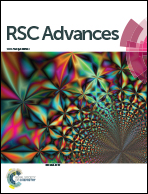Lactobacillus plantarum ZS2058 produces CLA to ameliorate DSS-induced acute colitis in mice†
Abstract
Lactobacillus plantarum ZS2058 is an efficient producer of conjugated linoleic acid (CLA) in vitro. To investigate whether L. plantarum ZS2058 produces CLA in vivo and exerts beneficial effects through CLA, an acute colitis model was induced with dextran sodium sulfate (DSS) in C57BL6/J mice. The mice were treated with L. plantarum ZS2058, L. plantarum ST-III, CLA, or vehicle 7 days before modeling until the end of modeling which lasts for seven days. Compared to L. plantarum ST-III, L. plantarum ZS2058 significantly inhibited the increase of the disease activity index (DAI), colon shortening and myeloperoxidase activity in colitic mice. L. plantarum ZS2058 treatment improved the histological damage, protected the colonic mucous layer integrity and significantly attenuated the expression of pro-inflammatory cytokines (TNF-α, IL-1β, IL-6), while up-regulated the expression of colonic anti-inflammatory cytokine IL-10 and nuclear receptor PPARγ. Furthermore, colonic CLA concentrations were significantly increased in response to L. plantarum ZS2058 treatment, which demonstrates that L. plantarum ZS2058 prevents colitis via producing CLA locally.


 Please wait while we load your content...
Please wait while we load your content...